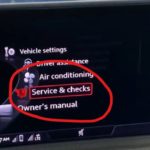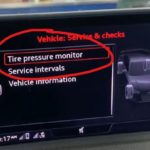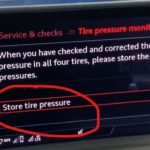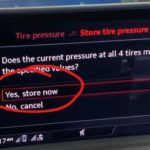HOW TO STORE/RESET TIRE PRESSURES
STEP 1: Select the Menu button.
STEP 2: Select Vehicle
STEP 3: Select Service & Checks
STEP 4: Select Tire Pressure Monitor
STEP 5: Select Store Tire Pressure
STEP 6: Select Yes, Store NOW
How Does the Audi A3/S3 Tire Pressure System Work?
The Audi A3 uses an indirect tire pressure monitoring system designed to optimize safety and performance by monitoring the car’s current tire pressure. This system employs the vehicle’s existing wheel speed sensors to monitor changes in tire pressure by assessing changes in wheel speeds. It’s worth noting that the Audi A3/S3 doesn’t use individual tire pressure sensors. If the system picks up on an irregularity that might suggest a deflated tire, a warning light will illuminate on the dashboard alerting the driver.
When to Reset Audi A3/S3 Tire Pressure Light?
After a tire rotation
Following a tire pressure adjustment
When replacing one or more tires
After installing new wheels or rims
If the TPMS warning light stays on after inflating a tire to the correct pressure
If the load/weight of the vehicle changes dramatically
After a seasonal tire change (switching between summer and winter tires)
If any wheel speed sensors are replaced
After any tire or wheel-related service or repair
In case of a low battery or after replacing the vehicle’s battery
What Sets Off Audi A3/S3 Tire Pressure Light?
Low tire pressure in one or more tires
A flat tire or slow leak due to puncture or damage
Significant changes in ambient temperature affecting tire pressure
Tire pressure inconsistency after tire rotation without resetting the iTPMS
Mismatched tire sizes or types on the vehicle
Uneven tire wear or irregular tread patterns
Incorrect tire inflation during maintenance or service
Malfunctioning or damaged wheel speed sensors
TPMS software or calibration issues
A low, dead or jumped vehicle battery can affect the tire pressure monitoring systems functionality
What Happens To Underinflated Tires?
When the tire pressure in an Audi A3/S3 is underinflated it can negatively impact the vehicle’s performance, safety, and fuel efficiency. Underinflated tires have a larger contact area with the road, increasing rolling resistance and leading to higher fuel consumption. Also, underinflated tires generate excessive heat due to increased friction which may result in premature tire wear, reduced tire lifespan, and even tire failure. Handling and braking capabilities may also be compromised making the vehicle less responsive and stable.







